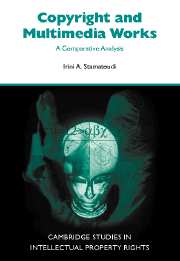Book contents
- Frontmatter
- Contents
- Acknowledgments
- List of abbreviations
- Introduction
- 1 Placing multimedia products within the scope of copyright
- 2 The scope of multimedia works
- 3 Traditional literary works
- 4 Collections and compilations
- 5 Databases
- 6 Audiovisual works
- 7 Computer programs
- 8 Video games as a test case
- 9 Multimedia products and existing categories of copyright works
- 10 A regime of protection for multimedia products
- 11 Conclusions
- Postscript
- Bibliography
- Index
9 - Multimedia products and existing categories of copyright works
Published online by Cambridge University Press: 25 July 2009
- Frontmatter
- Contents
- Acknowledgments
- List of abbreviations
- Introduction
- 1 Placing multimedia products within the scope of copyright
- 2 The scope of multimedia works
- 3 Traditional literary works
- 4 Collections and compilations
- 5 Databases
- 6 Audiovisual works
- 7 Computer programs
- 8 Video games as a test case
- 9 Multimedia products and existing categories of copyright works
- 10 A regime of protection for multimedia products
- 11 Conclusions
- Postscript
- Bibliography
- Index
Summary
ORIGINALITY AND QUALIFICATION FOR COPYRIGHT PROTECTION
Having examined the existing categories of copyright works that might eventually be capable of accommodating multimedia products, and having identified the difficulties they would present if they were to serve the needs of these products, one might wonder whether it would be a wiser solution to afford copyright protection to a multimedia work irrespective of whether or not it comes within one of the existing categories of copyright works. In other words, one should examine whether the classification of a new work is a necessary prerequisite for the work to attract copyright protection. The essential question therefore is whether a multimedia work can qualify for copyright protection by reason of its originality alone if, of course, it is taken for granted that a multimedia work is by nature a ‘work’ that is adequately fixed to meet the criterion of fixation in those countries where such a criterion is indispensable for the qualification of a work as a copyright work.
The answer to this question necessarily involves two aspects or considerations. One aspect is whether in all national copyright laws, classification of a work is a necessary prerequisite for it to attract copyright protection. The second is, where such a requirement is not present, whether the option of the protection of a multimedia product outside the special regime of a particular class of works, i.e. as a traditional literary work, a film, a computer program, etc., suffices for its protection and satisfies its needs fully.
- Type
- Chapter
- Information
- Copyright and Multimedia ProductsA Comparative Analysis, pp. 186 - 210Publisher: Cambridge University PressPrint publication year: 2001



